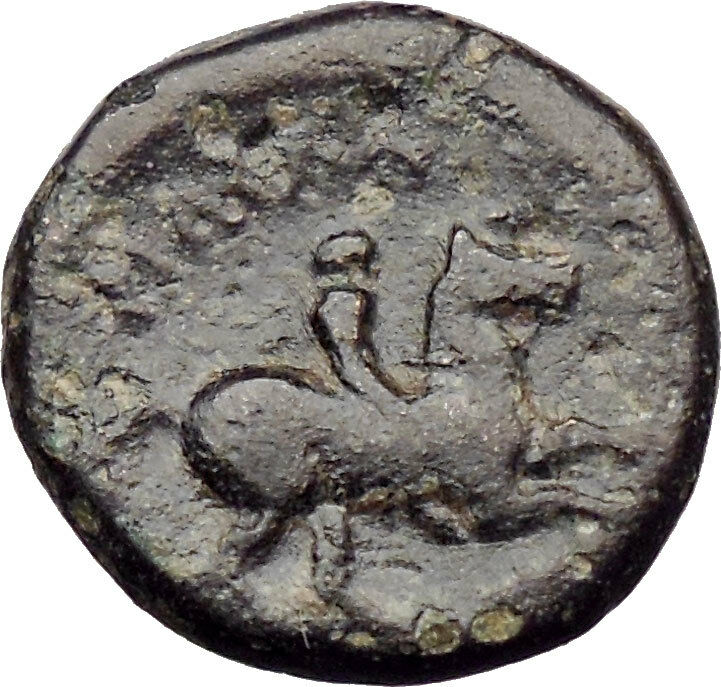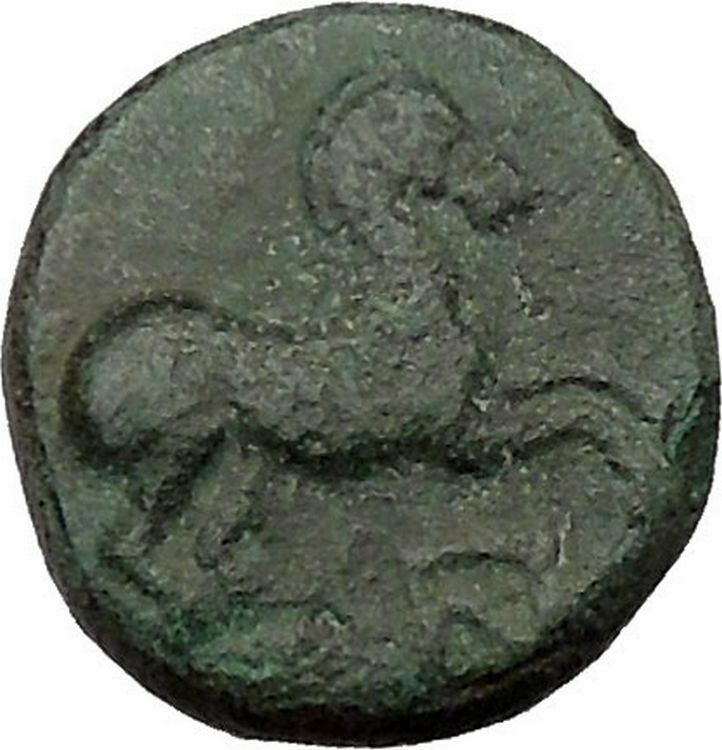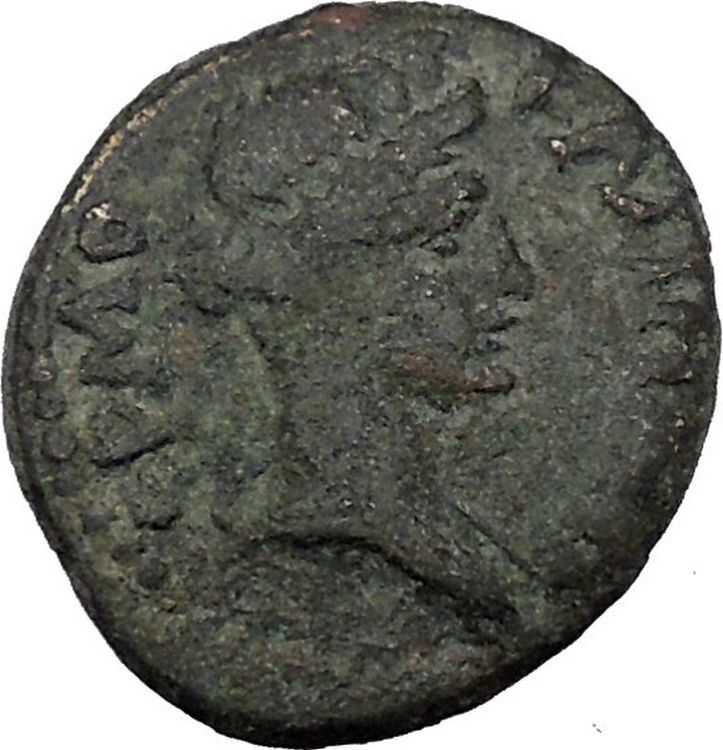|
Greek city of Hypaepa in Lydia
Pseudo-autonomous issue. Time of Commodus, circa 182-184 A.D.
Bronze 17mm (3.00 grams) Hermolaos II Theophilou (strategos)
Reference: RPC IV 3003 (online); SNG Copenhagen 186; SNG von Aulock -.
Pedigree: Ex Tom Cederlind
СΤ ƐΡΜΟΛΑΟV, Head of bearded Hercules right.
VΠΑΙΠΗΝΩΝ, Asclepius standing facing, leaning on serpent-entwined (medicine symbol) staff.
You are bidding on the exact item pictured, provided with a Certificate of Authenticity and Lifetime Guarantee of Authenticity.
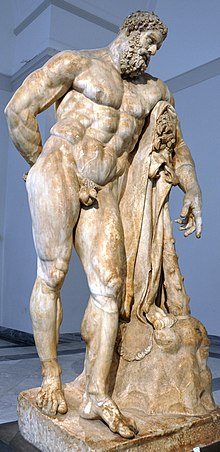 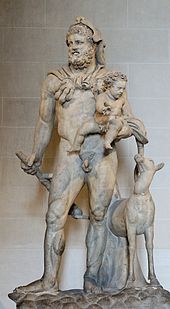 Heracles, born Alcaeus (Alkaios) or Alcides, was a divine hero in Greek mythology, the son of Zeus and Alcmene, foster son of Amphitryon and great-grandson and half-brother (as they are both sired by the god Zeus) of Perseus. He was the greatest of the Greek heroes, a paragon of masculinity, the ancestor of royal clans who claimed to be Heracleidae and a champion of the Olympian order against chthonic monsters. In Rome and the modern West, he is known as Hercules, with whom the later Roman emperors, in particular Commodus and Maximian, often identified themselves. The Romans adopted the Greek version of his life and works essentially unchanged, but added anecdotal detail of their own, some of it linking the hero with the geography of the Central Mediterranean. Details of his cult were adapted to Rome as well. Heracles, born Alcaeus (Alkaios) or Alcides, was a divine hero in Greek mythology, the son of Zeus and Alcmene, foster son of Amphitryon and great-grandson and half-brother (as they are both sired by the god Zeus) of Perseus. He was the greatest of the Greek heroes, a paragon of masculinity, the ancestor of royal clans who claimed to be Heracleidae and a champion of the Olympian order against chthonic monsters. In Rome and the modern West, he is known as Hercules, with whom the later Roman emperors, in particular Commodus and Maximian, often identified themselves. The Romans adopted the Greek version of his life and works essentially unchanged, but added anecdotal detail of their own, some of it linking the hero with the geography of the Central Mediterranean. Details of his cult were adapted to Rome as well.
Extraordinary strength, courage, ingenuity, and sexual prowess with both males and females were among the characteristics commonly attributed to him. Heracles used his wits on several occasions when his strength did not suffice, such as when laboring for the king Augeas of Elis, wrestling the giant Antaeus, or tricking Atlas into taking the sky back onto his shoulders. Together with Hermes he was the patron and protector of gymnasia and palaestrae. His iconographic attributes are the lion skin and the club. These qualities did not prevent him from being regarded as a playful figure who used games to relax from his labors and played a great deal with children. By conquering dangerous archaic forces he is said to have “made the world safe for mankind” and to be its benefactor. Heracles was an extremely passionate and emotional individual, capable of doing both great deeds for his friends (such as wrestling with Thanatos on behalf of Prince Admetus, who had regaled Heracles with his hospitality, or restoring his friend Tyndareus to the throne of Sparta after he was overthrown) and being a terrible enemy who would wreak horrible vengeance on those who crossed him, as Augeas, Neleus and Laomedon all found out to their cost.
![Asclepius with his serpent-entwined staff[1]](https://upload.wikimedia.org/wikipedia/commons/thumb/9/97/Statue_of_Asklepios_NAMA_263_(DerHexer).JPG/200px-Statue_of_Asklepios_NAMA_263_(DerHexer).JPG)  Asclepius is the god of medicine and healing in ancient Greek religion. Asclepius represents the healing aspect of the medical arts; his daughters are Hygieia (“Health”), Iaso (“Medicine”), Aceso (“Healing”), Aglæa/Ægle (“Healthy Glow”), and Panacea (“Universal Remedy”). The rod of Asclepius, a snake-entwined staff, remains a symbol of medicine today, although sometimes the caduceus, or staff with two snakes, is mistakenly used instead. He was associated with the Roman/Etruscan god Vediovis. He was one of Apollo‘s servants. Asclepius is the god of medicine and healing in ancient Greek religion. Asclepius represents the healing aspect of the medical arts; his daughters are Hygieia (“Health”), Iaso (“Medicine”), Aceso (“Healing”), Aglæa/Ægle (“Healthy Glow”), and Panacea (“Universal Remedy”). The rod of Asclepius, a snake-entwined staff, remains a symbol of medicine today, although sometimes the caduceus, or staff with two snakes, is mistakenly used instead. He was associated with the Roman/Etruscan god Vediovis. He was one of Apollo‘s servants.
 The rod of Asclepius, also known as the asklepian, is an ancient symbol associated with astrology, the Greek god Asclepius and with medicine and healing. It consists of a serpent entwined around a staff. The name of the symbol derives from its early and widespread association with Asclepius, the son of Apollo, who was a practitioner of medicine in ancient Greek mythology. His attributes, the snake and the staff, sometimes depicted separately in antiquity, are combined in this symbol. The Rod of Asclepius also represents the constellation Ophiuchus (or Ophiuchus Serpentarius), the thirteenth sign of the sidereal zodiac. Hippocrates himself was a worshipper of Asclepius. The rod of Asclepius, also known as the asklepian, is an ancient symbol associated with astrology, the Greek god Asclepius and with medicine and healing. It consists of a serpent entwined around a staff. The name of the symbol derives from its early and widespread association with Asclepius, the son of Apollo, who was a practitioner of medicine in ancient Greek mythology. His attributes, the snake and the staff, sometimes depicted separately in antiquity, are combined in this symbol. The Rod of Asclepius also represents the constellation Ophiuchus (or Ophiuchus Serpentarius), the thirteenth sign of the sidereal zodiac. Hippocrates himself was a worshipper of Asclepius.
Hypaepa was an Ancient city and (arch)bishopric in ancient Lydia, near the north bank of the Cayster River, and 42 miles from Ephesus, Ephesus and remains a Latin Catholic titular see.
Name and location
Its name was derived from its situation at the foot of Mount Aipos, itself a southern foothill of Mount Tmolus,
Its location was identified by the Frenchmen Cousinéry and Texier and confirmed by the excavations carried out by Demostene Baltazzi on behalf of the Ottoman government in 1892. The ruins are close to the present-day village of Günlüce (earlier known as Datbey or Tapaı; in the Ottoman vilayet of Smyrna), 4 kilometres northwest of the town of Ödemiş.
Its position looking towards the plain of Caystrus, was a strategic one on the route between Sardis and Ephesus.
History
In 88 BC, Hypaepa rebelled against Mithridates VI of Pontus and was severely punished.[3] Under Roman Emperor Tiberius (AD 14-37) it was selection as a candidate for the location of a temple dedicated to worship of the Emperor, but was rejected as being too insignificant.
In fact, the Roman poet Ovid contrasted the great city of Sardis with what he called “little Hypaepa”: Sardibus hinc, illinc parvis finitur Hypaepis.
Coinage of Hypaepa of the 3rd century AD are extant, until the time of Emperor Gallienus.
To judge by the number of Byzantine churches that it contained, Hypaepa flourished under the Byzantine Empire.[3]
Mythology and pre-christian religion
The women of Hypaepa were reputed to have received from the mythological Aphrodite the gift of beauty of form and dancing Ovid placed at Hypaepa the home of Arachne before she was turned into a spider.
The Persian goddess Anahita, identified with Artemis and therefore called Artemis Anaitis or Persian Artemis, was worshipped at Hypaepa, which had been part of the Achaemenid Empire. However, under the Roman Empire the priests of the temple bore Greek names, not Persian.
Pausanias mentions a rite performed in Hypaepa, in which wood was set alight apparently by magic.
An inscription from the synagogue of Sardis mentions a benefactor who was a member of the council of Hypaepa, indicating the presence there of a Jewish community.
Ecclesiastical history
Bishopric
Hypaepa was an episcopal see, one of many suffragans of Ephesus, the metropolitan see of the late Roman province of Asia Prima. It remained active until the 13th century.
Under Byzantine emperor Isaac II Angelus Comnenus (1185-1195 and 1203-1204) it became a Metropolitan see.
Lequien (Oriens Christianus I, 695) mentions six bishops: Mithres, present at the First Council of Nicaea in 325; Euporus, at the First Council of Ephesus in 431; Julian, at Ephesus, 449, and at the Council of Chalcedon in 451; Anthony, who abjured Monothelism at the Third Council of Constantinople in 680; Theophylactus, at the Second Council of Nicaea in 787; Gregory, at the Council of Constantinople in 879. To these may be added Michael, who in 1230 signed a document issued by the Patriarch Germanus II (Revue des études grecques, 1894, VII).
Titular see
The Latin diocese was nominally restored as titular bishopric around 1900 as Hipæpa (Curiate Italian Ipæpa) and renamed Hypæpa in 1933.
It is vacant since decades, having had the following incumbents, all of the lowest (episcopal) rank :
- Edward Gilpin Bagshawe, Oratorians of Philip Neri (C.O.) (1902.01.27 – 1904.01.17), previously Bishop of Nottingham (England, UK) (1874.10.12 – 1901.11.25?), later Titular Archbishop of Seleucia Trachea (1904.01.17 – 1915.02.06)
- Augustin Henninghaus (韓寧鎬), Divine Word Missionaries (S.V.D.) (1904.08.07 – 1939.07.20)
- Raymond Aloysius Lane (林化東), Maryknoll Fathers (M.M.) (1940.02.13 – 1946.04.11)
 Lydia was an Iron Age kingdom of western Asia Minor located generally east of ancient Ionia in the modern western Turkish provinces of Uşak, Manisa and inland İzmir. Its population spoke an Anatolian language known as Lydian. Lydia was an Iron Age kingdom of western Asia Minor located generally east of ancient Ionia in the modern western Turkish provinces of Uşak, Manisa and inland İzmir. Its population spoke an Anatolian language known as Lydian.
At its greatest extent, the Kingdom of Lydia covered all of western Anatolia. Lydia (known as Sparda by the Achaemenids) was a satrapy (province) of the Achaemenid Persian Empire, with Sardis as its capital. Tabalus, appointed by Cyrus the Great, was the first satrap (governor). (See: Lydia (satrapy).)
Lydia was later the name of a Roman province. Coins are said to have been invented in Lydia around the 7th century BC.
|






 Heracles, born Alcaeus (Alkaios) or Alcides, was a divine hero in Greek mythology, the son of Zeus and Alcmene, foster son of Amphitryon and great-grandson and half-brother (as they are both sired by the god Zeus) of Perseus. He was the greatest of the Greek heroes, a paragon of masculinity, the ancestor of royal clans who claimed to be Heracleidae and a champion of the Olympian order against chthonic monsters. In Rome and the modern West, he is known as Hercules, with whom the later Roman emperors, in particular Commodus and Maximian, often identified themselves. The Romans adopted the Greek version of his life and works essentially unchanged, but added anecdotal detail of their own, some of it linking the hero with the geography of the Central Mediterranean. Details of his cult were adapted to Rome as well.
Heracles, born Alcaeus (Alkaios) or Alcides, was a divine hero in Greek mythology, the son of Zeus and Alcmene, foster son of Amphitryon and great-grandson and half-brother (as they are both sired by the god Zeus) of Perseus. He was the greatest of the Greek heroes, a paragon of masculinity, the ancestor of royal clans who claimed to be Heracleidae and a champion of the Olympian order against chthonic monsters. In Rome and the modern West, he is known as Hercules, with whom the later Roman emperors, in particular Commodus and Maximian, often identified themselves. The Romans adopted the Greek version of his life and works essentially unchanged, but added anecdotal detail of their own, some of it linking the hero with the geography of the Central Mediterranean. Details of his cult were adapted to Rome as well.![Asclepius with his serpent-entwined staff[1]](https://upload.wikimedia.org/wikipedia/commons/thumb/9/97/Statue_of_Asklepios_NAMA_263_(DerHexer).JPG/200px-Statue_of_Asklepios_NAMA_263_(DerHexer).JPG)
 Asclepius is the god of medicine and healing in ancient Greek religion. Asclepius represents the healing aspect of the medical arts; his daughters are Hygieia (“Health”), Iaso (“Medicine”), Aceso (“Healing”), Aglæa/Ægle (“Healthy Glow”), and Panacea (“Universal Remedy”). The rod of Asclepius, a snake-entwined staff, remains a symbol of medicine today, although sometimes the caduceus, or staff with two snakes, is mistakenly used instead. He was associated with the Roman/Etruscan god Vediovis. He was one of Apollo‘s servants.
Asclepius is the god of medicine and healing in ancient Greek religion. Asclepius represents the healing aspect of the medical arts; his daughters are Hygieia (“Health”), Iaso (“Medicine”), Aceso (“Healing”), Aglæa/Ægle (“Healthy Glow”), and Panacea (“Universal Remedy”). The rod of Asclepius, a snake-entwined staff, remains a symbol of medicine today, although sometimes the caduceus, or staff with two snakes, is mistakenly used instead. He was associated with the Roman/Etruscan god Vediovis. He was one of Apollo‘s servants. The rod of Asclepius, also known as the asklepian, is an ancient symbol associated with astrology, the Greek god Asclepius and with medicine and healing. It consists of a serpent entwined around a staff. The name of the symbol derives from its early and widespread association with Asclepius, the son of Apollo, who was a practitioner of medicine in ancient Greek mythology. His attributes, the snake and the staff, sometimes depicted separately in antiquity, are combined in this symbol. The Rod of Asclepius also represents the constellation Ophiuchus (or Ophiuchus Serpentarius), the thirteenth sign of the sidereal zodiac. Hippocrates himself was a worshipper of Asclepius.
The rod of Asclepius, also known as the asklepian, is an ancient symbol associated with astrology, the Greek god Asclepius and with medicine and healing. It consists of a serpent entwined around a staff. The name of the symbol derives from its early and widespread association with Asclepius, the son of Apollo, who was a practitioner of medicine in ancient Greek mythology. His attributes, the snake and the staff, sometimes depicted separately in antiquity, are combined in this symbol. The Rod of Asclepius also represents the constellation Ophiuchus (or Ophiuchus Serpentarius), the thirteenth sign of the sidereal zodiac. Hippocrates himself was a worshipper of Asclepius.
 Lydia was an Iron Age kingdom of western Asia Minor located generally east of ancient Ionia in the modern western Turkish provinces of Uşak, Manisa and inland İzmir. Its population spoke an Anatolian language known as Lydian.
Lydia was an Iron Age kingdom of western Asia Minor located generally east of ancient Ionia in the modern western Turkish provinces of Uşak, Manisa and inland İzmir. Its population spoke an Anatolian language known as Lydian.

